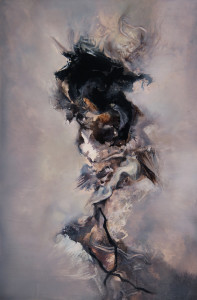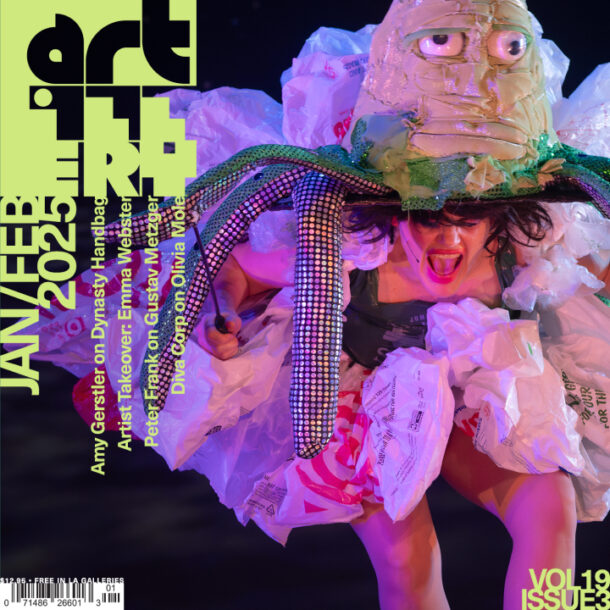We all know what brought us to Los Angeles; the question is what makes us stay. I hate driving; but the one good thing about being pulled occasionally off the beaten path (inevitably by car in L.A.) is the opportunity to see what has changed (disconcertingly, sometimes dramatically), what has (inexplicably) remained more or less the same, and what has declined or decayed. It’s hard to resist speculating on the possible narratives—mundane, traumatic, fantastical, absurd. In L.A., the absurd or fantastical frequently converges with the everyday. Some chic retail space or restaurant fills what was once a trash-strewn, pissed-over car park. A venerable theatre is suddenly (depressingly) a mini-mall. A car parts shop is now an exclusive designer boutique.
You see it in smaller ways, too: the architectural or landscape details; gardens overgrown or abandoned; streets pitted and potholed beyond redemption; a person’s dress or circumstances radically altered, and (disturbingly) their entire affect with it. ‘Oh brave new world that has such people (and things) in it.’
You scan this world in a slightly different way from behind a windshield/screen than you do from the sidewalk. The view streams in advancing horizon lines, into and around your peripheral vision before fading to the micro-panorama receding in the rear-view mirror. From an elevated grade or overpass, it’s both more pictorial and less picturesque. The sense of duration is slightly altered. The sense of the moment is lost. It can get lost in the car, too—until we register something in our peripheral vision that’s double-take worthy. ‘What the hell was that?’ Sometimes, we actually stop and check it out. Sometimes it’s just the odd piece of debris flying by; or a dog or hedgehog or—(fill-in-the-odd-pet-of-choice). And sometimes it all but defies description.
It we look at it again, we may have yet another take on it, visually (or mentally) contextualizing it. And we move on—or not. We may spend some time (willingly or not) mentally re-contextualizing, re-configuring the object or specimen. It becomes the armature for something else; a sort of metamorphosis, or maybe just a souvenir.
So after this somewhat roundabout meander south and westward (noticing how swanked up Third Street between Crescent Heights and La Cienega is starting to look), I came to Matthew Marks for Charles Ray’s show, only to find them closing the gallery. Thinking about that post-facto metamorphosis: had I already been anticipating something like this on the drive over? (Not really—my schedule/timing’s always off; one more reason I’m always late.) Still the gallery press release was intriguing in that regard (maybe a little infuriating, too—as Charles Ray so often is).
“Baled Truck is a sculpture that commemorates solidity and compression — as in memory, what seems assembled from the past is in reality carved from the present.” ‘Yes, I suppose,’ you might nod in quiet agreement. Here’s the eye-rolling part, though: “Baled Truck, shown here for the first time, is a sculpture of a truck that has been compressed into a rectangular block. Machined from solid stainless steel, the sculpture weighs twelve tons.” Oh—so it’s about compressing a 12-ton stainless steel truck (that was one clean-looking truck, dontch’ya think?) into a rectangular block. ‘Uh-huh—shoot me now,’ you think. Well he knows how to get us going—doesn’t he? Yes, I’ll be back.
And so I moved on to Richard Telles Fine Art for Thomas Eggerer’s show. Two BIG paintings in two separate galleries. I was still dealing with my hangover from the Los Angeles Opera Barrie Kosky production of Bartok’s Bluebeard’s Castle—thinking how Kosky might have benefited from a conversation about abstract color fields with Eggerer. But the first painting in the main gallery space was actually pretty greiged-out, so that wouldn’t necessarily have been the best starting point. This was a new approach for Eggerer. There has always been a tension between the pared down figurative/gestural element and color fields which oscillate between the suggestively atmospheric and the aggressively (almost threateningly) abstract. This was different. The (always minimal) gestural element was eliminated; the usually articulate silhouetted figures here pared down to pictogram-schematic. What was interesting was the way it scanned—left to right, top to bottom, in serried ranks (the subject was a harvest—workers in a field picking fruit/vegetables/etc., with trucks/harvesting vehicles moving among the laborers). There’s a sense of distance (parallel to the element of duration and abstraction, the real-time scan) and dislocation (from physical actuality, labor). The second painting was more ‘identifiably’ Eggerer—crouching figures (also in a field, as if berry-picking), articulated silhouettes etched out of a thinly scumbled red field.
That contrast between the flat ‘envelope’ and the line-by-line scan—not just the subject matter or hieroglyphic figuration—evoked both the moment of immersive perception and a certain archaic technology. The line-by-line scan is familiar from (pre-digital) television technology—and how far have we really come from it? (Or is that just L.A.-damage?)
From there it was on to Culver City, where naturally I missed Mark Dean Veca at Western Project (though I’m sure I missed the actual opening by at least a week) and the Tansaekhwa show at Blum & Poe. Hmmm…. (Yes of course I’m going back.) I’m not sure how much I liked Canan Tolon’s Like at von Lintel (more on that another time); but on my way out, I ran into the stylish and all-knowing Camilla Taylor, who steered me to a new gallery and a real discovery. The gallery was Bustamante Gill and the discovery was Kim Kei.
Kim Kei was not what I had in mind as I drove through the L.A. scan and its transient aesthetic loci. But here was something like that inchoate metamorphosis going on in the back of my mind—the windblown specimen transforming itself while still crossing my field of vision to manifest some minutes, weeks, or perhaps even a geological epoch later, reconstituted, reconfigured, reincarnated. She works in and across several media—painting, sculpture and photography; but all of her work has a very ‘painterly’ look and feel (not that I actually touched the sculptures, which I only saw as photographed)—not simply gestural, but as if painted, reassembled in her imagination.
The sculptures appear to begin (I was about to use the word, ‘generate’) with a naturalistic armature. (I’m sure what she uses varies with each sculpture—they could be steel or plastic for all I know—but some of them have the look of driftwood or bone.) Several of them appeared turned or torqued along their vertical axis. To this variously molded, shaped, twisted armature, Kei wraps, glues, solders, paints or otherwise applies or affixes fragments or cuttings of fabric, feathers, wood, plastic, porcelain, string, wire; occasionally interwoven with some vegetation or natural element (e.g., things that look like vegetables, sponge or seed pods) sometimes dyed, painted or otherwise tinted. Some of the objects have the look of funnels or plumes of fabric (and flesh) or simply petrified vegetation; some of them bird-like or vaguely ornithological; some ruined architectural fragments or fantastic couture regalia arrayed on some fashionably posed (biomorphic) form—a sculptural ‘vogue-ing’. (Bohemian Society’s Victor Wilde and Rick Owens should take note.) The color palette is broad; but grays, pinks, smoky blues seem to catch the light (along with the veined, the shiny, light-catching swale or swag); the overall cast of the photographs is a mauve iridescence.
At first glance, I almost thought the photographs were paintings (and I thought to compare them to painters like Glenn Brown, but I quickly realized this was quite wrong). The sensibility comes closer to 18th century French and Dutch still life, especially studies of dead or decaying game and vegetables. A more recent point of comparison might be an artist like Odilon Redon. The sculptures are lit with some deliberation and photographed against mostly black or gray or violet-mauve-backdrops. Surreal, fantastical, deliberately abstracted, yet manifestly connected to the natural, material world; fascinated with decay and morbidity, but also metamorphosis, transformation—ebullient, vibratile—these were some of the contradictory, ambiguous qualities summed up by the title of the show, Somewhere Between.
The actual paintings (on panel and canvas) continue this dialectic between abstraction and ‘naturalism’—their willful abstraction contending with a ‘naturalistic’ hand; their fragmented, fossilized abstract ‘still life’ studies broadly serving abstract gesture. This is a style enjoying a certain resurgence in recent years, but rarely seen at this level of acuity and originality.
After the almost hallucinatory pitch of this show, I was looking for something to gently return me to gravity’s field (as opposed to ‘laying me in the earth’), and fortunately I only had to walk across the street to do it. Luke Diiorio’s paintings and site-specific sculptures at Anat Ebgi functioned as a minimalist (both structurally and chromatically) take on both the notion of ‘scan’ and a certain ambiguous ‘transformative’ moment. The linear scan was here also a horizontal fold in canvas or linen; and both paintings and sculptural pieces (essentially variously treated drywall fragments) addressed the perceptual ‘folds’ that may variously hold nothing or multitudes.
It was a much-needed ‘far from the madding crowd,’ almost Zen-like moment. And then I ran into Stefan Simchowitz, attired head-to-toe in Sterling Ruby/Raf Simons—which seemed timely, considering my recent feature. The evening wasn’t over by a long shot.




